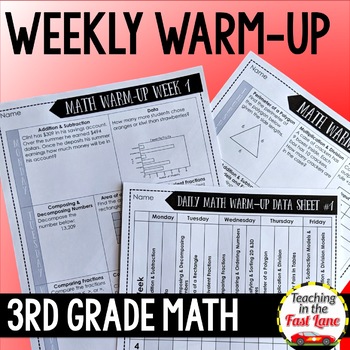3rd Grade Math Morning Work - Bell Ringer or Warm Up Activity - Spiral Review
- PDF
What educators are saying
Description
Are you looking for a 3rd Grade Math Warm Up that will spiral standards throughout the year? Look no further than this resource that can be used as a warm up, bell ringer, or morning work!
------------------------------------------------------
This 3rd Grade Math Warm Up is a 36 week long daily review of important math concepts for 3rd grade. It is based on the thirteen readiness standards outlined in the 3rd grade math TEKS andthen aligned to CCSS when appropriate.
------------------------------------------------------
This 3rd Grade Math Warm Up resource includes:
•Teacher Directions
•Tips for Implementation
•A Layout Key for the warm up
•3rd grade math CCSS Alignment Key
•3rd grade math TEKS Alignment Key
•I Can Statements
•36 Weeks of Weekly Review
•Student Data Tracking Pages
•Complete Answer Key
This resource is ready to print and go!
------------------------------------------------------
⬆️Click the green square above to check out the preview for a more complete view of the resource.⬆️
------------------------------------------------------
Why Do I Need This 3rd Grade Math Warm Up Resource?
Practice Makes Permanent!
Each day students will review 2-3 math concepts to keep their learning fresh and preview standards before you get to them in the year. The format each week stays the same, but the problems change to continue to challenge students all year long!
------------------------------------------------------
Topics Covered in the 3rd Grade Math Warm Up:
- Mondays
- Addition and Subtraction
- solve with fluency one-step and two-step problems involving addition and subtraction within 1,000 using strategies based on place value, properties of operations, and the relationship between addition and subtraction
- Addition and Subtraction
- Data
- solve one- and two-step problems using categorical data represented with a frequency table, dot plot, pictograph, or bar graph with scaled intervals
- Data
- Tuesdays
- Composing and Decomposing Numbers
- compose and decompose numbers up to 100,000 as a sum of so many ten thousands, so many thousands, so many hundreds, so many tens, and so many ones using objects, pictorial models, and numbers, including expanded notation as appropriate
- Composing and Decomposing Numbers
- Area of a Rectangle
- determine the area of rectangles with whole number side lengths in problems using multiplication related to the number of rows times the number of unit squares in each row
- Area of a Rectangle
- Equivalent Fractions
- represent equivalent fractions with denominators of 2, 3, 4, 6, and 8 using a variety of objects and pictorial models, including number lines;
- Equivalent Fractions
- Wednesdays
- Comparing Fractions
- compare two fractions having the same numerator or denominator in problems by reasoning about their sizes and justifying the conclusion using symbols, words, objects, and pictorial models.
- Comparing Fractions
- Comparing and Ordering Numbers
- compare and order whole numbers up to 100,000 and represent comparisons using the symbols >, <, or =
- Comparing and Ordering Numbers
- Classifying and Sorting 2D and 3D Figures
- classify and sort two- and three-dimensional figures, including cones, cylinders, spheres, triangular and rectangular prisms, and cubes, based on attributes using formal geometric language
- Classifying and Sorting 2D and 3D Figures
- Thursdays
- Perimeter of a Polygon
- determine the perimeter of a polygon or a missing length when given perimeter and remaining side lengths in problems;
- Perimeter of a Polygon
- Multiplication and Division
- represent and solve one- and two-step multiplication and division problems within 100 using arrays, strip diagrams, and equations
- Multiplication and Division
- Number Pairs in Tables
- represent real-world relationships using number pairs in a table and verbal descriptions.
- Number Pairs in Tables
- Fridays
- Addition and Subtraction Models and Equations
- represent one- and two-step problems involving addition and subtraction of whole numbers to 1,000 using pictorial models, number lines, and equations
- Addition and Subtraction Models and Equations
- Multiplication and Division Models and Equations
- represent and solve one- and two-step multiplication and division problems within 100 using arrays, strip diagrams, and equations;
- Multiplication and Division Models and Equations
------------------------------------------------------
What Are Teachers Saying About the 3rd Grade Math Warm Up?
⭐️⭐️⭐️⭐️⭐️
I used this for morning work and it was easy for the kids to follow and to print and give out to the kids!
-Tamesia C.
⭐️⭐️⭐️⭐️⭐️
Oh I'm so excited to get this started in my classroom! I have another Daily Review but it's not as detailed as this one! This one fits right in with the rigor that I have been looking for! Thank you!
-Alicia M.
⭐️⭐️⭐️⭐️⭐️
This was a great way to practice and review standards. Loved the reflection piece to help keep students accountable for their learning.
-Jeri B.





